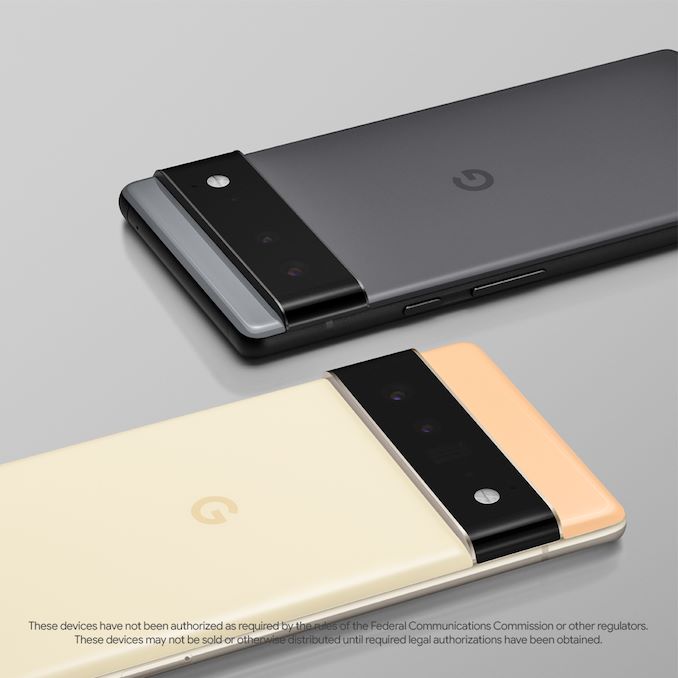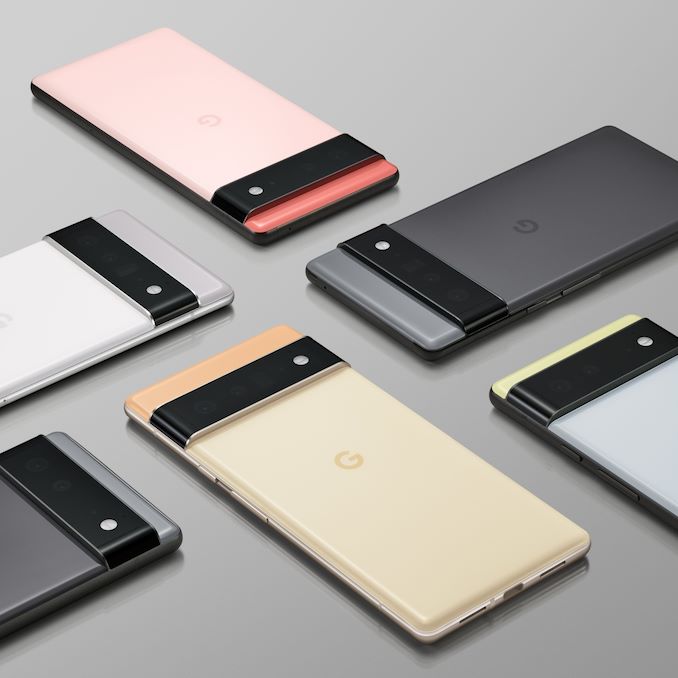Google Teases Pixel 6 and Pixel 6 Pro with new "Tensor" SoC
by Andrei Frumusanu on August 2, 2021 1:55 PM EST- Posted in
- Mobile
- Smartphones
- Pixel 6
- Pixel 6 Pro

Today Google has teased its new upcoming Pixel 6 and Pixel 6 Pro phones; in what is likely an attempt to get leaks and the upcoming narrative of the product under control, as opposed to the previous years of quite severe product spoilers several months ahead of the actual official product launches, the company is themselves revealing large important bits about the upcoming new flagship phones.
Google reveals that this year’s Pixel phones will be called the Pixel 6 and the Pixel 6 Pro, two seemingly similarly sized devices in a high-end configuration with some compromises, and one in an all-bells-and-whistles uncompromising device. In a more exclusive prebriefing with The Verge, it’s stated that the new devices will be truly flagship specced phones competing at the highest end of the market, marking an important step away from the mid-range of the last several years. This is a large shift for Google and has been one of our main criticisms over the last few years – a seeming lack of clear direction where Google wants to be with their Pixel phones, at least until now.
The first big news and confirmation from Google is the fact that the new Pixel 6 phones will be powered by a custom SoC that Google has dubbed the “Google Tensor”. For a few years now it had been rumoured that Google would be the first customer of Samsung LSI’s new semi-custom SoC business – essentially a design and manufacture for hire service that would allow OEMs to work very closely with SLSI in designing differentiated products. Essentially this would be the exact same business model AMD uses in partnership with the console vendors.
What’s interesting here is exactly what’s part Google, and what’s part Samsung LSI and stemming off from the Exynos SoC line-up. The one thing that had been assumed and has been confirmed today is that Google is employing their own AI/ML/NPU IP in the new chip, basically leveraging the company’s experience off their datacentre TPU hardware designs and IP, and integrating it into an SoC. In a sense, this also might be a successor to the Pixel Visual Core, with the large power efficiency and cost savings advantage that Google is now able to integrate it into the primary SoC.
In terms of other specifications of the SoC, there were no further details revealed at this time, but generally given the expected fall release date of the devices, it’s generally to be assumed that the chip would feature the same generation IP blocks in terms of CPU and GPU as other 2021 SoCs such as the Exynos 2100. This wouldn’t be a complete move away from past Pixel device’s release schedule not matching the industry’s IP release cadence – I would still expect the Q1 2022 SoCs to vastly out-spec it, but it’s at least a large improvement thanks to the new hardware differentiation.
The one large question that remains to see is how things play is in terms of the cellular capabilities – notably the device dropping Qualcomm as the preferred chipset vendor would also mean that this would be the only second other design besides Qualcomm featuring mmWave connectivity, which will be interesting to see. Samsung had noted back in 2019 that they had mmWave modules, and although we didn’t see them in 2020, maybe the new Pixel phones will be the first to feature them.
Material You will be best on #Pixel6.
— Made By Google (@madebygoogle) August 2, 2021
The colors, the camera, the form, and what’s on the screen all work together in a single, fluid experience.
(9/13) pic.twitter.com/K6BRF9ZKEY
In terms of the actual Pixel 6 phones, the Pixel 6 is advertised as having a 6.4” screen at a presumably lower FHD+ resolution, with flat glass design, while the Pixel 6 Pro is a 6.7” phone and a presumably QHD+ resolution. Both screens are reportedly 120Hz refresh rate as per the The Verge, though MKHD notes 90Hz on the regular unit.
The design of the new Pixels is defined by what Google describes as the “camera bar”, which is an interesting take on merging the needed camera bump and embracing it into the phone’s design. The large feature is very much unapologetic and horizontally covers the width of the phone, being rounded off to the sides. It somewhat reminds me of the Mi 11 Ultra bump, just much thinner and more subdued.
In terms of cameras, both phones feature an ultra-wide and a regular wide-angle, both with new sensors that are advertised to have much better light gathering capabilities. The Pixel 6 Pro also gets a periscope telephoto module with 4x optical magnification, meaning it’ll end up around 105mm equivalence. Google’s decision to go with a lower focal length here is I think extremely good as it avoids the large quality gap, and if the company employs a high-resolution sensor on the new module, it’ll still be able to have great spatial resolution at >8x magnification.
The camera software and processing are said to be extremely integrated with the new Tensor SoC and the ML IP block of the chip, enabling new features such as using HDRnet in video recording, running the same image pipelines that previously only were possible in still shots.
Google plans to formerly announced and launch the Pixel 6 and Pixel 6 Pro “this fall”.











46 Comments
View All Comments
gagegfg - Monday, August 2, 2021 - link
Google's Pixel have lost popularityA5 - Monday, August 2, 2021 - link
They never had it. Even the ones phone nerds think was "best" barely sold any units.hechacker1 - Monday, August 2, 2021 - link
I'm hoping for an updated Nest Cam with a TPU at this point. It would be more popular than the Pixel.:P
sharath.naik - Thursday, August 12, 2021 - link
Agree, only this seems more by design than any lack of direction within google. In my opinion they will never release a phone with everything you need, as they donot want to compete with others. Their main revenue source is Playstore. So they will only release a sub par phone just with things they want to try out so that others can catch up. For exmaple this pixel 6 will likely have sub par battery life with <=4000mah battery(while others have 5000mah), these will have only 12mp 4x zoom and a 12mp ultra wide camera sensor, seriously limiting its zoom range and it landscape capabilities.sharath.naik - Wednesday, August 18, 2021 - link
Looks like I may be wrong. Rumors leaks suggest, 5000mah battery and a 48MP 4x camera. If this is true, google would have finally released a phone that is not shortchanged in any practical way to its competition.sharath.naik - Thursday, August 12, 2021 - link
Currently VIVO x60 proplus is the only phone that has not nerfed its features either for future upgrade market (Like Samsung did with s21 utlra) or limiting feature so as to not compete like google does.sharath.naik - Monday, September 6, 2021 - link
Anandtech can you give an option to edit or delete comments. Its a bit silly to not give an option to retract comments.hechacker1 - Monday, August 2, 2021 - link
Looks like a fancy battery pack. I wonder how the front looks.All that matters is performance. Materials UI, meh. So many choices (if you like our pastel color pallet mixer).
shabby - Monday, August 2, 2021 - link
Here's hoping for 5 years of updates 🤞🤞🤞NextGen_Gamer - Monday, August 2, 2021 - link
Corrections to be made: The Verge article is based on their actual hands-on and official info given to them by Google. So I don't think there needs to be "presumably" and "assumed" words when mentioning their specs, as it is straight from the device maker. On that note, they flat out say the Pixel 6 Pro is a 6.7" QHD+ 120Hz screen, while the Pixel 6 is a 6.4" FHD+ 90Hz screen.